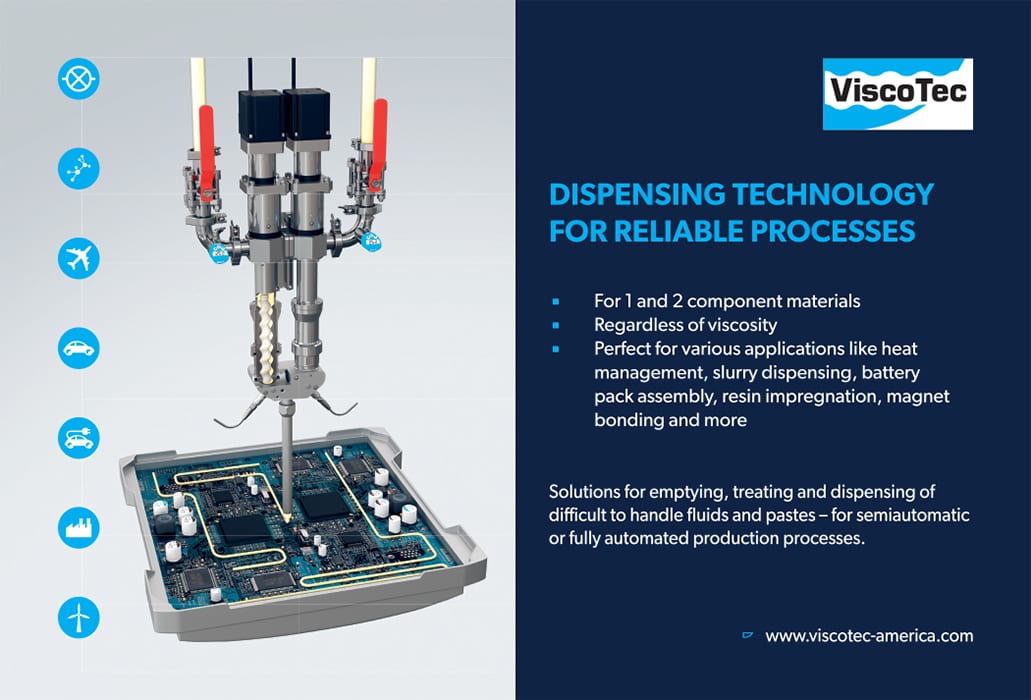
Sound absorption and noise dampening present huge challenges in electric vehicles.
The Quest for Quiet
John Challen, Contributing Writer
Automakers and suppliers are scrambling to reduce noise in electric vehicles. Photo courtesy Audi AG
Automotive engineers have been tackling unwanted vehicle noise for decades. Their focus consists of a combination of sounds and vibrations from a vehicle’s drivetrain, as well as ambient road noise from outside vehicles.
Reducing noise, vibration and harshness (NVH) becomes even more challenging with electric vehicles. Increasing levels of electrification mean even subtle noises are more pronounced than ever.
The emergence of EVs has led the automotive industry to a conundrum based around the dual issues of weight and noise. In most cases, the weight of cars powered purely by internal combustion engines (ICE) was not really an issue, so huge amounts of sound deadening materials could be used to mask the sound of that engine (and other noises) entering the cabin.
However, in the world of battery-powered transportation, every mile of vehicle range counts, which means that vehicles have to be as lightweight as possible to go as far as possible. While there might not be any noise coming from an engine, you can’t underestimate the whine of electric motors, the rumble of low-rolling resistance tires or the sound of rushing wind that can all disrupt quiet interiors.
According to a recent study conducted by BIS Research, the acoustic and thermal insulation material market for EVs will grow 21 percent annually over the next decade.
“Ancillary noises hamper the driving experience and disturb the acoustics from sound systems or haptic feedback while driving,” notes Shivam Priyadarshi, principal analyst at BIS Research. “The increasing application areas for insulation in electric vehicles have led to surging demand for various insulation materials, such as foams, fibers and rubber pads.”
However, EVs will also demand new types of sound absorption and sound dampening technology to ensure a quiet ride. This challenge is forcing automakers and suppliers to consider using a number of innovations that go beyond traditional foams, sealants and tapes. Here’s a look at a few of the options currently available to automotive engineers.
Electric vehicles demand new types of sound absorption and sound dampening technology to ensure a quiet ride for drivers and passengers. Illustration courtesy Molex LLC
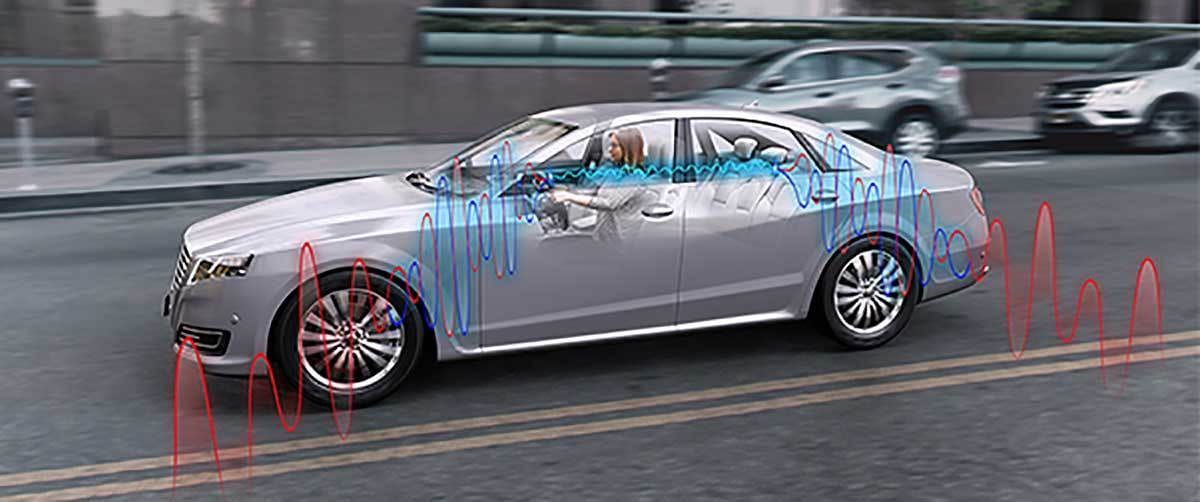
May the “Frunk” Be With You
“The mitigation of noise and vibration is a complex challenge that’s increasingly critical as the number of electric vehicle models proliferate,” says Davide Caprioli, head of acoustics and thermal management at Autoneum. “In the absence of ICE noise, the relative silence of an electric car accentuates the sounds emitted by the motor and caused by the vibration of structural components.
“The accelerated development of electric vehicles places enormous pressure on automotive OEMs to find optimal acoustic treatments and explore new sustainable materials as early as possible,” explains Caprioli.
Autoneum’s Ultra-Silent underbody system, which is up to 50 percent lighter than conventional plastic products, is currently used to absorb sound in a variety of vehicles. The company also recently developed a “frunk” specifically for use in EVs.
Replacing the space left by removing the engine from ICE cars and trucks, frunks provide extra storage space in a variety of vehicles. One example is the new Ford F-150 Lightning pickup truck, which provides a covered storage area at the front of the vehicle.
“The Ultra-Silent-based frunk improves vehicle acoustics,” claims Caprioli. “With no engine noise, external and internal sound sources, such as motors and compressors, are more audible in EVs.
See us at The ASSEMBLY Show Booth 1613
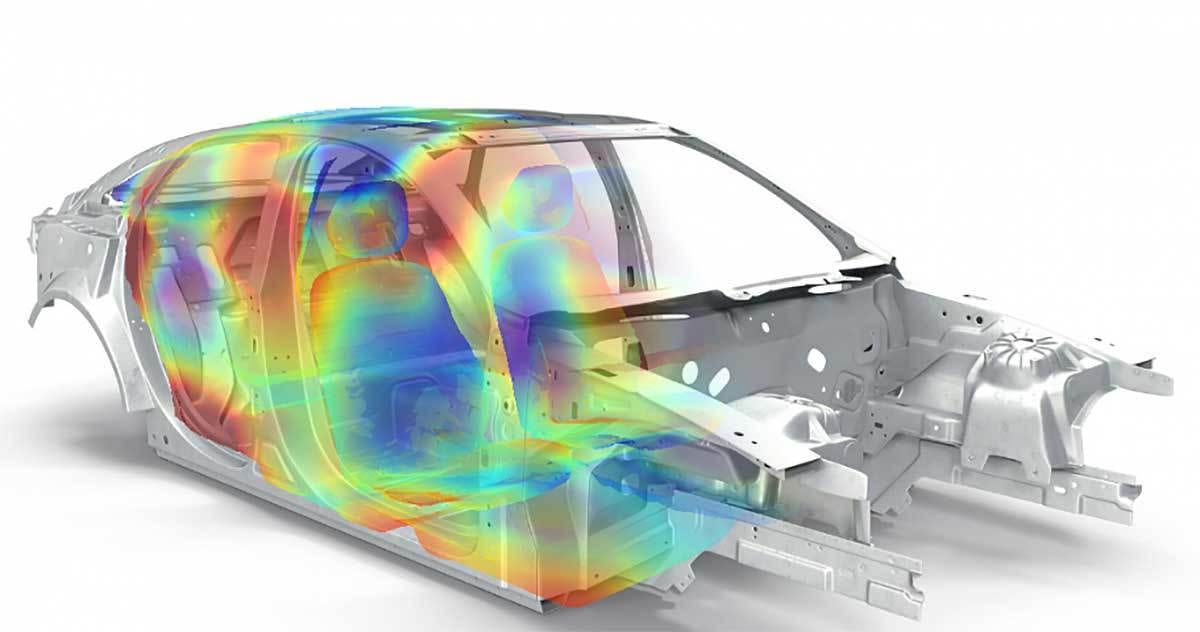
With no engine noise, external and internal sound sources, such as motors and compressors, are more audible in electric vehicles. Illustration courtesy Free Field Technologies
“Due to their sound-absorbing textile material composition, Ultra-Silent components reduce annoying noises at the source,” Caprioli points out. “Additionally, synergies with other acoustic components have a positive impact on the vehicle’s overall acoustic comfort. The frunk made of Ultra-Silent is highly sustainable as well. It is made entirely of polyethylene terephthalate and contains up to 70 percent recycled material.”
Caprioli predicts that future innovations in EV noise reduction will come from a strategic partnership between Autoneum and software specialist Free Field Technologies (FFT), a division of Hexagon. The goal of the joint venture is to use computer-aided engineering technology to help engineers design quiet and comfortable EVs without adding unnecessary weight.
The companies plan to incorporate Autoneum’s simulation methods for vehicle acoustics into FFT’s Actran modeling software.
“Accurate prediction of acoustic performance significantly reduces the time that engineers invest in design,” says Diego Copiello, product manager at FFT. “From the whine of the electric motor and vibration in the power train to noise from heating and air-conditioning units, wind resistance and tires, there are multiple variables that make acoustic design a complex challenge to solve.”
Automotive engineers are exploring new ways to make electric vehicles quiet. Photo courtesy Autoneum
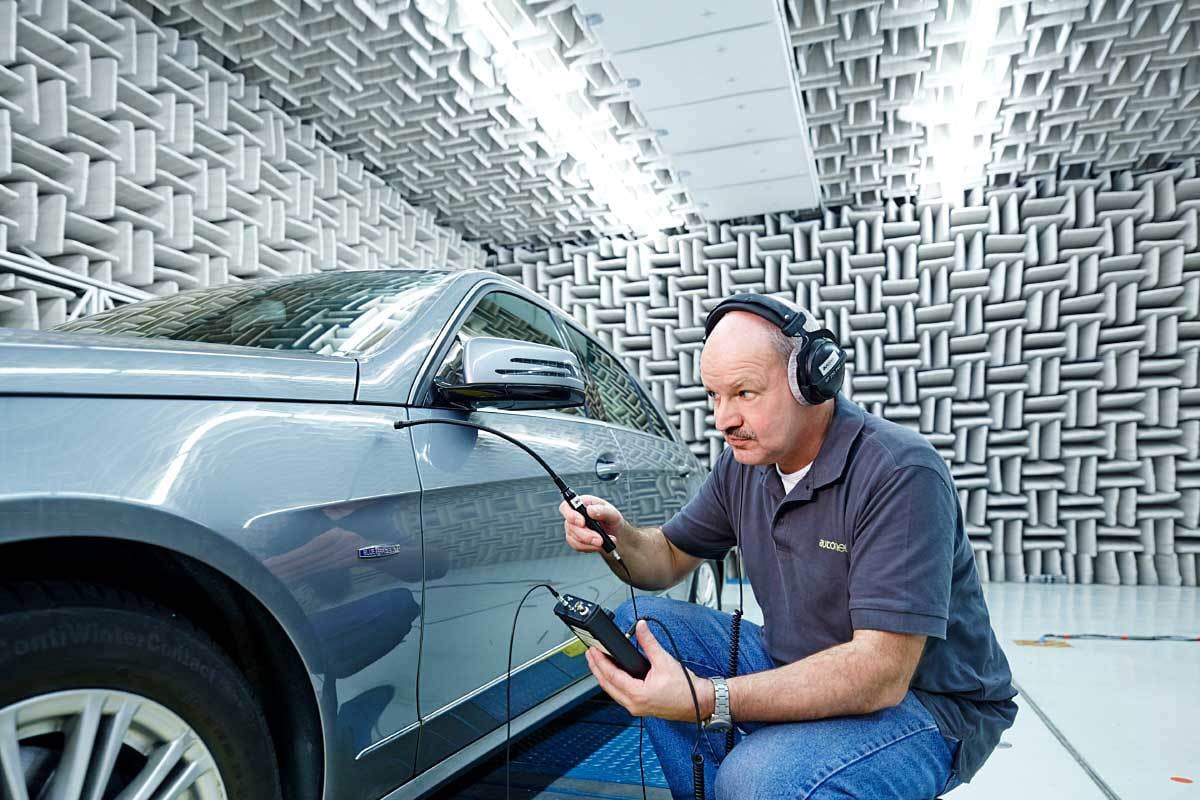
Interior Noise Simulation
When looking at noise reduction in EVs, it’s not just damping and sound absorption that has to be taken into account. Indeed, the total transmission process from source to excited sound has to be carefully considered and analyzed.
“The perceived sound quality in the vehicle interior is determined by tonal noise shares induced by the electric drivetrain, which are often unpleasant to the ear,” says Norbert Alt, Ph.D., executive vice president and chief operating officer at FEV Group GmbH. “In combination with other awkwardly perceived high noise shares of wind and tire sounds, the optimization process of the total interior sound of electric vehicles is challenging.”
To address the issue, FEV is applying simulation methods to describe the noise generation chain. Analysis tools, which are increasingly based on machine learning approaches, enable engineers to get a deep insight into the component sound parts.
In combination with acoustic investigations at the vehicle and component level, noise excitation mechanisms can be identified and disturbing noises reduced or even avoided. In addition, advanced equipment such as acoustic cameras and near-field holography are used for this purpose.
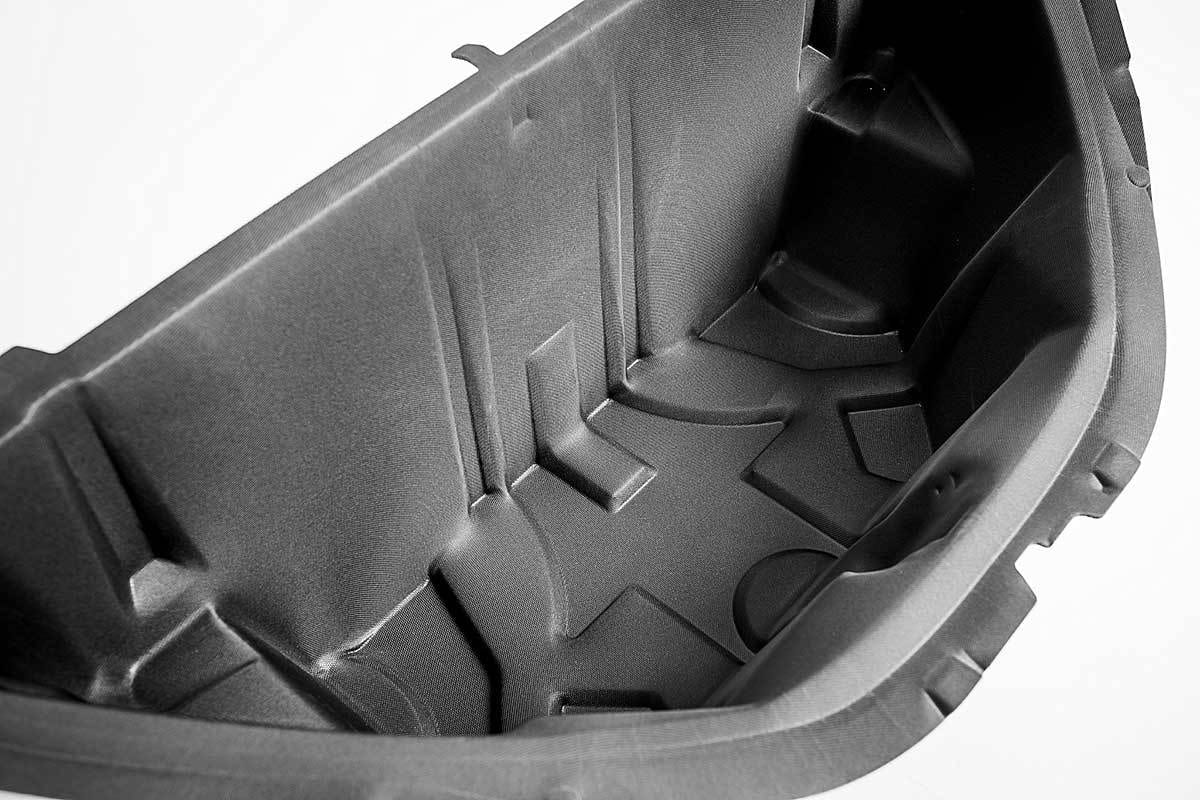
Sound-absorbing textile materials can help reduce annoying noises. Photo courtesy Autoneum
“An intensive knowledge about the vehicle’s relevant transfer paths is also necessary,” explains Alt. “Sophisticated tools based on transfer path analysis such as FEV VINS (Vehicle Interior Noise Simulation) are used to reveal recommendations for additional damping.
“These include mounts and absorbing by secondary measures,” says Alt. “Being under the constraint of weight and costs, these measures are therefore rated against these criteria.
“In addition to active and passive methods of noise reduction, the possibility of sound design arises,” Alt points out. “The frequency content of the dominating drivetrain, wind and tire shares must be considered to form a base to design a vehicle’s sound pack.”
FEV has already developed a modular tool to generate customized and unique sounds, with the possibility of real-time sound synthesis based on simulated driving data.
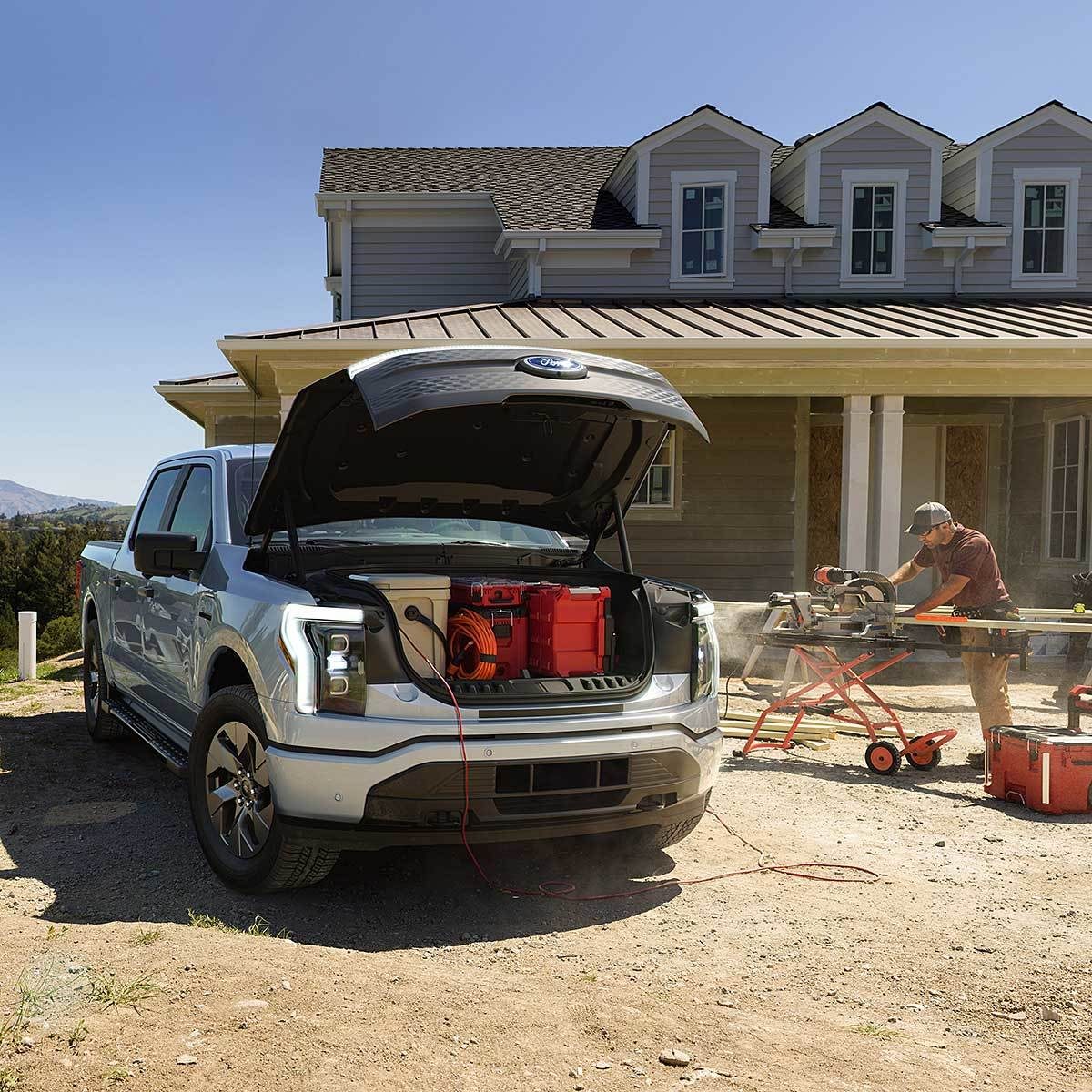
The new F-150 Lightning pickup truck features a “frunk” that provides extra storage space at the front of the vehicle. Photo courtesy Ford Motor Co.
Acoustic Pads
Acoustic systems for EVs need to be light, easy to handle and invisible after installation. Electric drives generate much less noise than ICEs. That means other sounds, such as the rolling of tires, airstream or creaking sounds, are much more noticeable.
Inverters are another common source of noise. Frequency is typically around 8 kilohertz (kHz), although it may range anywhere between 4 and 12 kHz. In other words, more noise at lower and higher frequencies needs to be absorbed.
Combining acoustics with thermal insulation is becoming increasingly important. In winter, an electric car’s air conditioning system is used to generate heat, which means it requires some of the battery’s power and therefore reduces battery range. So, thermal insulation for components is attracting a great deal of interest.
Acoustic Pads developed by the Freudenberg Group meet all these requirements. By maximizing the fiber-air distribution, the company’s traditional absorbers already provide some thermal insulation. Thermal conductivity of just 0.02 watts per meter-kelvin is achieved through the use of aerogels.
Electric vehicles require new types of sound and vibration testing equipment. Photo courtesy FEV Group GmbH

“Generally speaking, the sound absorption performance of porous absorbers can be fine-tuned by adjusting the weight, the thickness and the proportion of fine-fibers,” says Svetlana Schoenhals, sales manager at Freudenberg. “[We have] combined two core competencies from [our] apparel padding business and filtration activities to achieve this. These two fields of expertise are ultra-light, maximum-volume dry-laid nonwovens and microfiber nonwovens. Both have a defined flow resistance and convert the kinetic energy of the sound into thermal energy.
“We use the ultra-light, maximum-volume dry-laid nonwovens, because absorption in the lower to mid-frequency range improves as the thickness increases,” explains Schoenhals. “An ultra-light, high-volume absorber, plus an air flow resistance layer that is as dense as possible, achieves other effects similar to those of a flexible panel absorber, thus helping to absorb sound. Combining porous absorbers and plate transducers allows us to cover a broader bandwidth by selecting the absorber thickness.”
The sound absorption performance of porous materials can be fine-tuned by adjusting the weight, thickness and proportion of fine fibers. Illustration courtesy Freudenberg
Advanced sensor technology can be used to capture and cancel road noises. Illustration courtesy Molex LLC
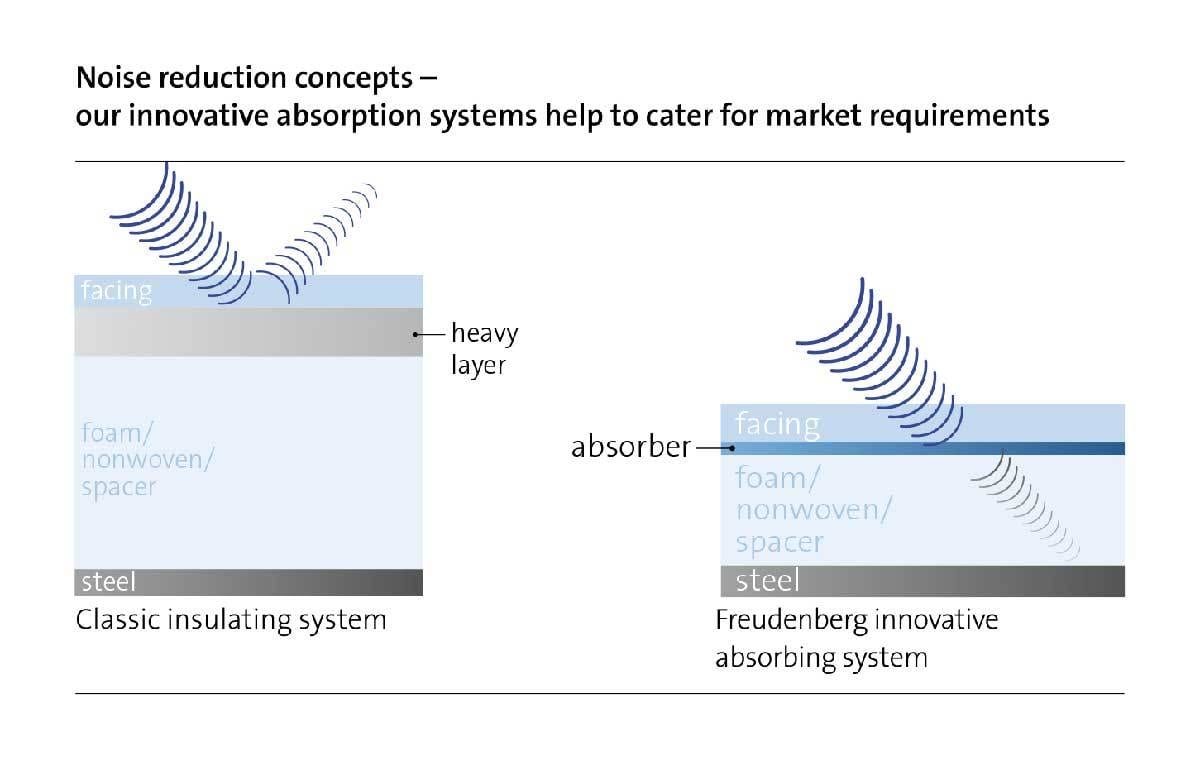

Quiet Aluminum
Many startup EV manufacturers turn to aluminum to save weight. However, the fact that it is lightweight doesn’t automatically eradicate noise levels or sources. Mass is actually very good for a quiet car, but when you lighten up the vehicle many of the systems and components used to reduce sound end up adding a lot of weight.
During a research exercise, engineers at Material Sciences Corp. (MSC) discovered that many types of damping treatments are used in aluminum vehicles. To avoid this, they developed Quiet Aluminum, which consists of two skins of aluminum bonded together with a viscoelastic core. In essence, the core is a very thin polymer that is approximately 0.02-millimeter thick. The skins are generally the same thickness for formability, but they can be formed of different widths.
“Quiet Aluminum is a lightweight, formable engineered laminate that delivers the weight-saving advantage of aluminum components without the need for additional thickness or add-on sound deadening materials to meet NVH targets,” says Matt Murphy, chief technical officer at MSC. “It is an ideal material for EV applications where both qualities—light weight and reduced NVH—are at a premium.
“The viscoelastic core was developed to allow the two aluminum layers to sheer at a micro level, creating high-quality damping,” explains Murphy. “That eliminates add-on treatments, which translate into big weight savings.”
According to Murphy, some treatments used on aluminum components can be very thick. For instance, mastics up to 4 millimeters thick are used on some light-duty trucks, because noise is such a problem. So, in some cases, damping treatments can end up weighing just as much as the aluminum parts.
MSC uses several different recipes for its viscoelastic core. One is designed for a higher temperature environment, while the other is for ambient temperature applications. As a result, some MSC customers use Quiet Aluminum on inverters, which have high-frequency noise issues.
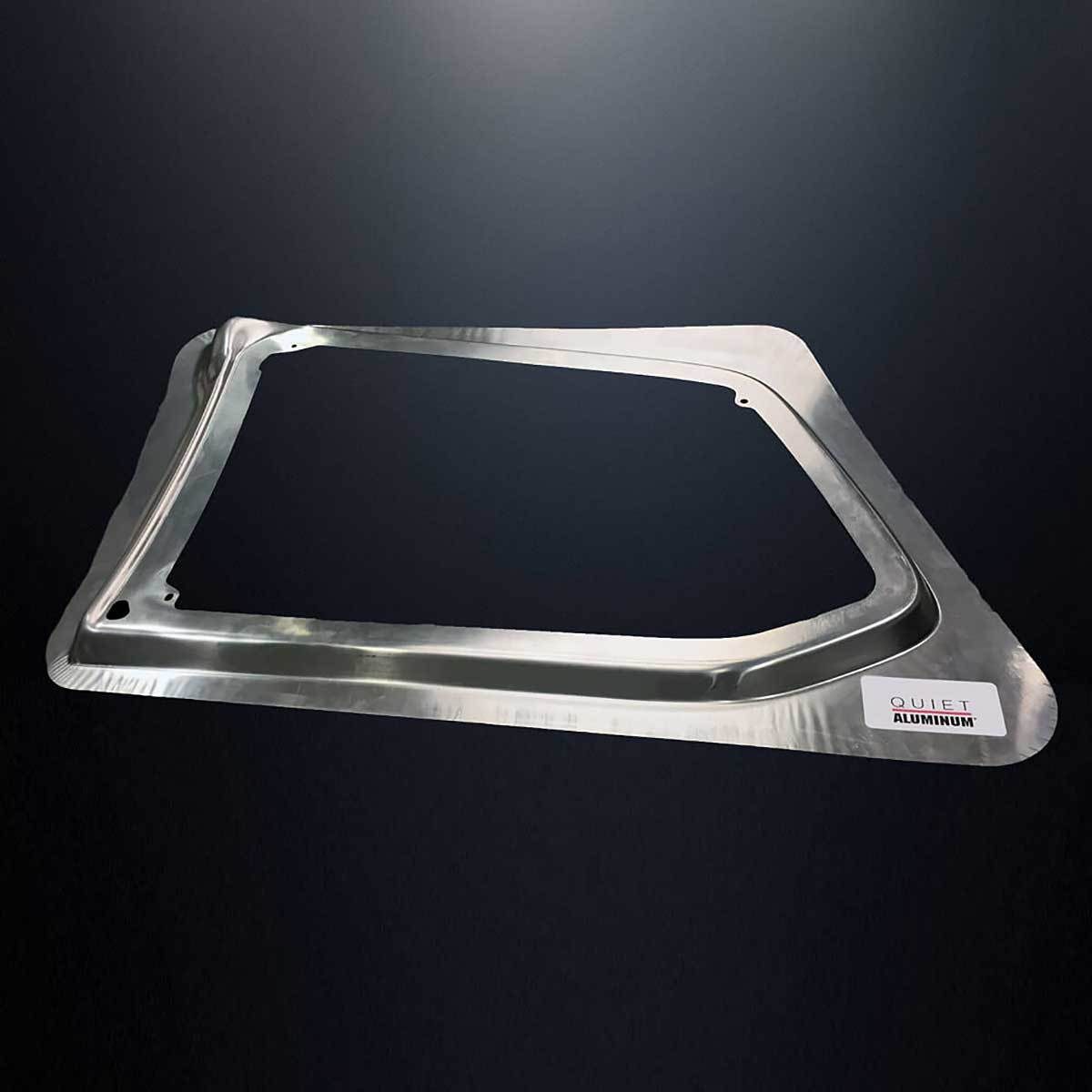
Quiet Aluminum is a lightweight, formable engineered laminate that delivers weight-savings without the need for additional thickness or add-on sound deadening materials. Photo courtesy Material Sciences Corp.
Noise Cancelling Sensors
Advanced sensor technology can be used to capture and cancel road noises. Sound reduction is managed by capturing noise signatures using microphone- and accelerometer-based devices. These sensors play a critical role in combatting unwanted road, wind and HVAC car noise, while reducing low-frequency sounds that increase driver fatigue.
Molex LLC and Silentium Ltd. are currently working together to develop active noise cancellation systems. Early this year, Molex unveiled an accelerometer-based device that is the first product in a new family of automotive active noise cancellation sensors. Molex also announced that its RNC sensor has been tested and validated with Silentium’s Active Acoustics software, which removes up to 90 percent of unwanted noises across a broad band of frequencies (from 20 Hz to 1 kHz) to improve driver comfort and safety.
“As the transition to electrified vehicles intensifies, it will become critical to reduce road noise, which today is masked by internal combustion engines,” says Carrieanne Piccard, vice president and general manager of the Transportation Solutions Business Unit at Molex. “In particular, the elimination of frequent humming or droning noises coming from roads and tires is critical to decreasing ‘highway hypnosis’ and driver fatigue.”
Active noise cancellation technology uses sensors on each wheel to constantly monitor vibrations from the road surface. It then calculates the opposite phase sound wave needed to remove the noise heard by vehicle occupants. By monitoring in real-time, unexpected noises from potholes or rough surfaces can be isolated and removed via an advanced cabin sound system.
Silentium’s noise cancelling system is already being adopted by leading automotive suppliers and OEMs, such as Jaguar Land Rover.
“The technology, introduced on the Jaguar F-PACE, Jaguar XF and Range Rover Velar, is capable of lowering unwanted noise peaks by 10 decibels (dB) and overall noise levels by 3 to 4 dB, which is the equivalent of turning down the in-car sound system by four ‘steps,’” claims Yoel Naor, CEO of Silentium. “This significant reduction in exposure to low-frequency noises up to 300 Hz can help prevent driver fatigue on longer journeys.”

This lightweight acoustic meta-material uses a combination of a lattice structure and plastic film to control air vibrations. Photo courtesy Nissan Motor Corp.
New-Age Acoustic Insulation
Other automakers are also developing new technology to make EV interiors quieter. Engineers at Nissan Motor Corp. recently developed a lightweight acoustic meta-material that uses a combination of a lattice structure and plastic film to control air vibrations. This configuration limits the transmission of wide-frequency band noise (500 to 1200 Hz), such as road and power train sounds.
Prior to the introduction of the new insulation material, other items used to isolate this frequency band consisted mainly of rubber board. Nissan’s meta-material weighs 25 percent less than these, while providing the same degree of sound isolation.
Because of its simple structure, the material is cost-competitive vs. traditional types of insulation. Therefore, it can also be used in vehicles where the use of sound insulation materials is currently limited due to cost or weight.
“We plan to use acoustic meta-material in a wide range of applications, not only in luxury cars and electric vehicles,” says Susumu Miura, an advanced material engineer at Nissan in charge of the project. “Through development and use of this material, we aim to make our customers’ driving experience more comfortable and enjoyable.”
Automakers rely on a variety of sound and vibration measurement equipment to develop quieter electric vehicles. Photo courtesy Bruel & Kjaer
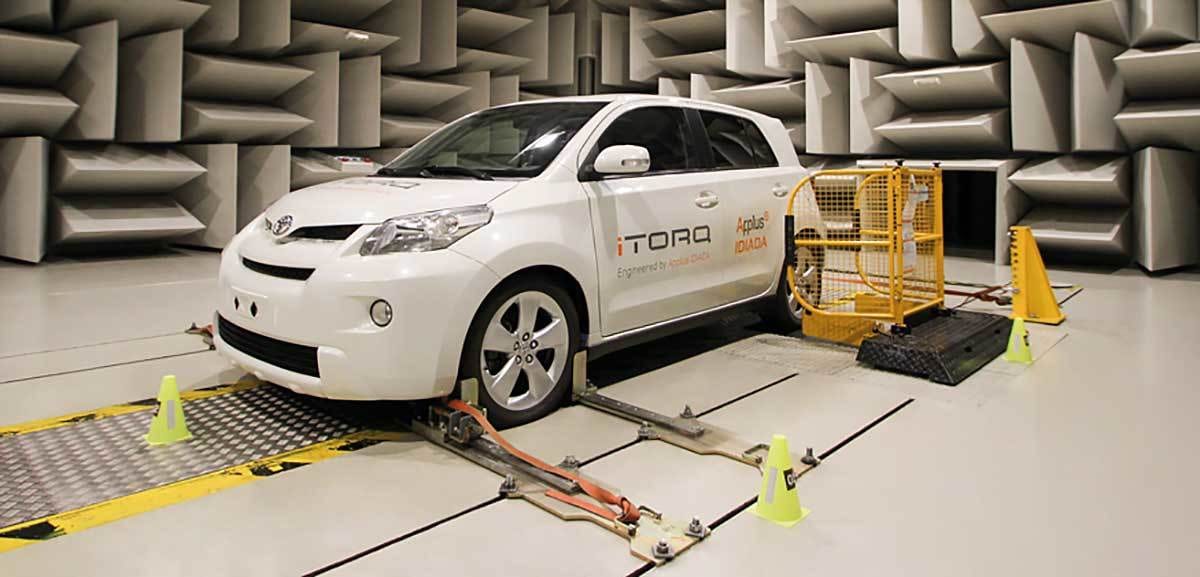
Active Road Noise Control
Noise damping is a way of preventing vibration in vehicle bodies by converting the vibrations into heat. It works by reducing energy stored in an oscillation. The goal is to slow down an oscillatory system as fast as possible by adding noise damping materials into the system. Reduction of the duration and size of vibration a vehicle experiences will result in a reduction in noise.
For decades, Bose Corp. has been known for high-quality speakers and audio systems. However, its engineers have now turned their attention to minimizing unwanted sound in EVs caused by driving over rough roads, grooved concrete and uneven pavement.
Conventional approaches to solving this problem typically include adding thick insulation to the vehicle body, using customized tires that trade drive performance for lower noise, and other passive countermeasures that can increase vehicle weight and drive down fuel efficiency.
To address the issue, Bose’s automotive division recently developed a smarter, more flexible and adaptable electronic solution that uses a vehicle’s existing sound system. QuietComfort relies on a combination of accelerometers, proprietary signal-processing software, microphones and the vehicle’s audio system to electronically control unwanted sound.
Accelerometers mounted on the vehicle body enable an algorithm to continuously measure vibrations that create noise. This information is then used to calculate an acoustic cancellation signal, which is delivered through the vehicle’s speakers to reduce the targeted noise. Microphones placed inside the cabin monitor residual noise levels, allowing the system to adapt the control signal for optimized performance over different road surfaces, while automatically adjusting over time as the vehicle ages.
“For years, we’ve been asked why we can’t simply adapt our noise cancelling headphone technology to vehicle cabins for a quieter driving experience,” says John Feng, manager of active sound management solutions at Bose Automotive. “But, it’s much more difficult to control noise in a large space like a car cabin compared to the relatively small area around your ears. Through research advances and our relentless efforts to solve tough problems, we’ve [now achieved a level of road noise reduction that sets us] apart from competitive offerings.”
SEPTEMBER 2021 | ASSEMBLYMAG.com

Scroll to
read full article
